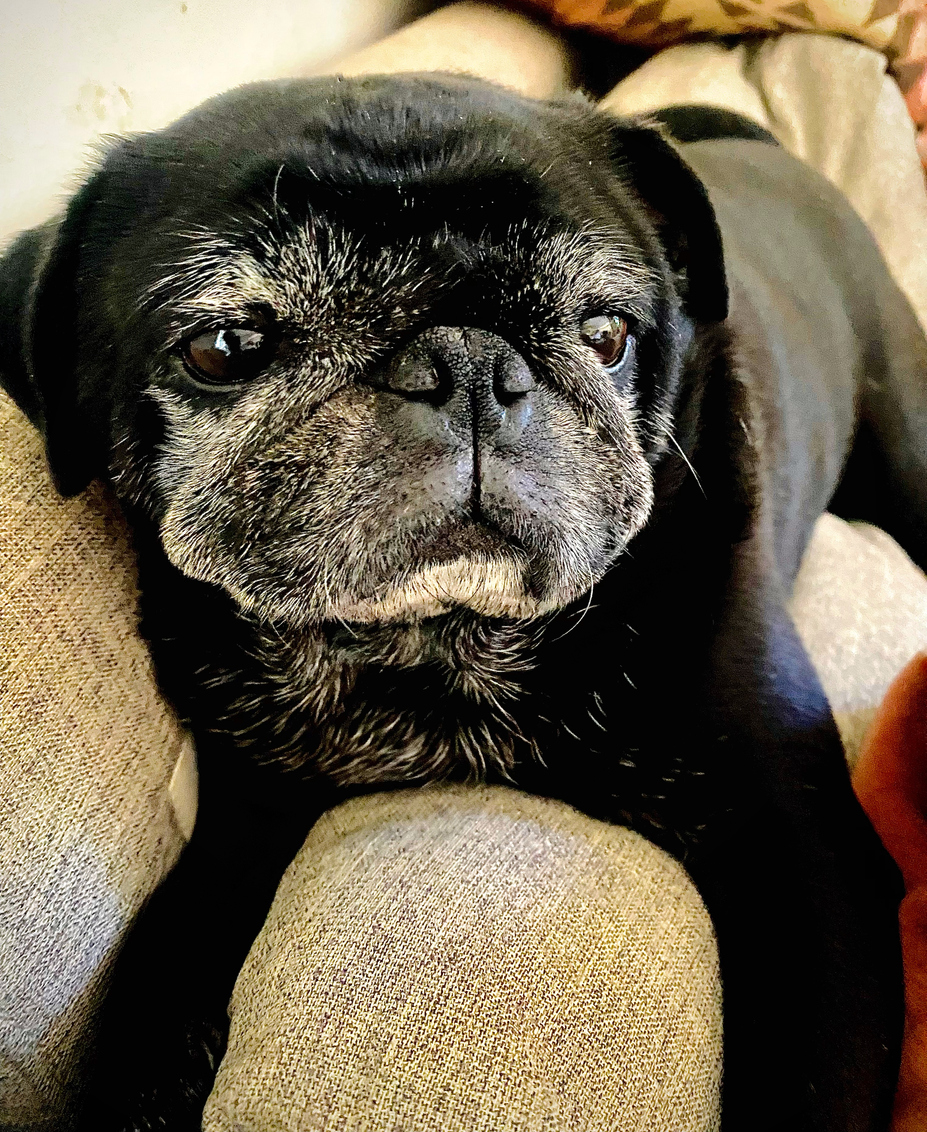Brachycephalic Airway Syndrome
What does brachycephalic mean?
Brachy means shortened and cephalic means head. Therefore, brachycephalic pets have skull bones that are shortened in length, giving the face and nose a pushed-in appearance. Due to the shorter bones of the face and nose, the anatomy and relationship with the other soft tissue structures are altered; some of these changes can cause physical problems for the affected dog.
Brachycephalic canine breeds include Bulldogs (French and English), Boxer Dogs, Boston Terriers, Pekingese, Chinese Shar-Pei, Pugs, Lhasa Apsos, Shih Tzus, and Bull Mastiffs. For cats these include Persians, Himalayan and Burmese cats.

What is brachycephalic airway syndrome?
Brachycephalic airway syndrome refers to a particular set of upper airway abnormalities that affect brachycephalic dogs and cats. This syndrome is also called brachycephalic respiratory syndrome, brachycephalic syndrome, or congenital obstructive upper airway disease. The upper airway abnormalities that occur in this syndrome include:
Stenotic nares. Dogs with stenotic nares have abnormally narrowed or small nostrils; the narrowing restricts the amount of air that can flow into the nostrils.
Extended nasopharyngeal turbinates. Nasopharyngeal turbinates are ridges of bone covered by tissue that help humidify and warm air that is inhaled. When these extend past the nose into the pharynx (the area behind the nose and mouth), they cause variable amounts of airflow obstruction.
Elongated soft palate. A dog and cat with an elongated soft palate (the soft part of the roof of the mouth) has a soft palate that is too long for the length of the mouth; the excess length partially blocks the entrance to the trachea (windpipe) at the back of the throat.
Laryngeal collapse. Laryngeal collapse is caused by the chronic stress placed on the cartilage of the larynx by other features of brachycephalic airway syndrome. Eventually, the larynx (voice box) is not able to open as wide as normal, causing further restriction in airflow.
Everted laryngeal saccules. The laryngeal saccules are small sacs or pouches that are located just inside the larynx; these saccules evert (turn outwards) or are sucked into the airway by pressure associated with the increased respiratory effort caused by the stenotic nares and/or the elongated soft palate. Everted laryngeal saccules will further obstruct airway flow.
Hypoplastic trachea. A hypoplastic trachea means that the trachea has a smaller diameter than normal.
An individual pet with brachycephalic syndrome may be affected by a combination of one or more of these abnormalities.
What other problems can occur because of brachycephalic airway syndrome?
Brachycephalic airway syndrome has been linked to changes in the lungs, as well as in the gastrointestinal tract, including bronchial collapse, gastroesophageal reflux, and chronic gastritis. In bronchial collapse, the bronchi (the airways that connect the trachea to deeper airways of the lungs) weaken and collapse, causing further obstruction. Gastroesophageal reflux occurs when intestinal fluids flow back into the esophagus (the tube that connects the throat to the stomach).
What are the clinical signs of brachycephalic airway syndrome?
Any of these upper airway abnormalities can cause increased airway resistance, increasing the effort required to inhale. Most pets with this syndrome breathe more easily through their mouths than their noses. The more abnormalities present, the more severe the signs.
Mildly affected pets will have noisy breathing, especially with exercise, and most will snort when excited and snore when relaxed or asleep. Severely affected pets have more pronounced airway noise, appear to tire easily with exercise, and may collapse or faint after exercise. Other signs may include coughing, gagging, retching, and vomiting. Signs are often worse in hot or humid weather; affected pets are more prone to overheating, as the ability to pant to lower body temperature is compromised. Pets with impacts to their gastrointestinal tract may show signs including retching, vomiting, or lack of appetite.
Over time, pets with this syndrome may develop other secondary problems, including inflammation of other structures in the airways. In the long term, the increased effort associated with breathing can put increased strain on the heart.
Most pets are diagnosed with brachycephalic airway syndrome between one and four years of age. Both males and females appear to be affected equally. Pets with multiple abnormalities tend to develop problems at an earlier age.

How is brachycephalic airway syndrome diagnosed?
This syndrome will be diagnosed based on your pet’s breed, facial conformation, clinical signs, and results of a physical examination. Stenotic nares can usually be diagnosed on visual inspection. Diagnosis of an elongated soft palate, everted laryngeal saccules, or other associated anatomical changes in the mouth will require heavy sedation or full general anesthesia.
Since pets with this syndrome have an increased risk of complications associated with general anesthesia, your veterinarian will recommend pre-anesthetic blood work and chest X-rays to evaluate the general health of your pet and minimize the risks. If your pet undergoes general anesthesia to diagnose this condition, your veterinarian will likely recommend that any necessary surgical correction be performed at the same time.
What is the treatment for brachycephalic airway syndrome?
Since obesity worsens the signs of brachycephalic airway syndrome, weight loss is an important part of treatment if your pet is overweight. For pets with only mild or intermittent signs, the condition may be managed conservatively by controlling exercise levels, avoiding hot or humid conditions, keeping the pet in an air-conditioned area during the summer, and avoiding stress.
Corticosteroids, nonsteroidal anti-inflammatory drugs (NSAIDs), and oxygen therapy may all be useful for short-term relief of airway inflammation or respiratory distress. However, medical management of this condition does not correct the underlying anatomical abnormalities.
Surgery is the treatment of choice whenever the anatomic abnormalities interfere with the pet’s breathing. Stenotic nares can be surgically corrected by removing a wedge of tissue from the nostrils, allowing improved airflow through the nostrils. An elongated soft palate can be surgically shortened to a more normal length. Everted laryngeal saccules can be surgically removed to eliminate the obstruction in the larynx.
How successful is surgery?
The earlier the abnormalities associated with this syndrome are corrected, the better the outcome. The condition worsens over time and may cause other abnormalities. Early correction of stenotic nares and/or an elongated soft palate will significantly improve airway function and may prevent the development of everted laryngeal saccules.
In the early post-operative period, swelling of the surgical sites may occur and interfere with breathing. Therefore, your veterinarian will closely monitor your pet after the surgery has been performed. The degree of monitoring that will be necessary depends on the surgical procedures that were performed.

What is the prognosis for a pet with brachycephalic airway syndrome?
The overall prognosis for pets with brachycephalic airway syndrome depends on how many anatomic abnormalities are present and how old the pet is at the time of diagnosis and treatment. Pets under two years of age at the time of surgical correction have a better post-operative prognosis than pets that are older. Pets that only require surgical correction for stenotic nares and/or an elongated soft palate have a better prognosis than pets with more defects. Pets with a hypoplastic trachea have a variable prognosis. Pets that have other problems, such as allergic airway disease, or that have developed secondary problems from the airway distress, have a poorer prognosis. However, appropriate management can significantly improve the quality of life for these pets.
Is there any other advice?
Dogs with brachycephalic airway syndrome should be fitted with a harness that does not tug at the neck area. It is not advisable to use a regular neck collar for these dogs since a collar can put undue pressure on the neck. This syndrome is directly related to the conformation or breed standard for brachycephalic pets. Pets with pronounced breathing difficulty or that require surgery to correct airway obstruction should not be used for breeding. It is usually recommended that these pets be spayed or neutered at the same time the surgical correction is performed.



